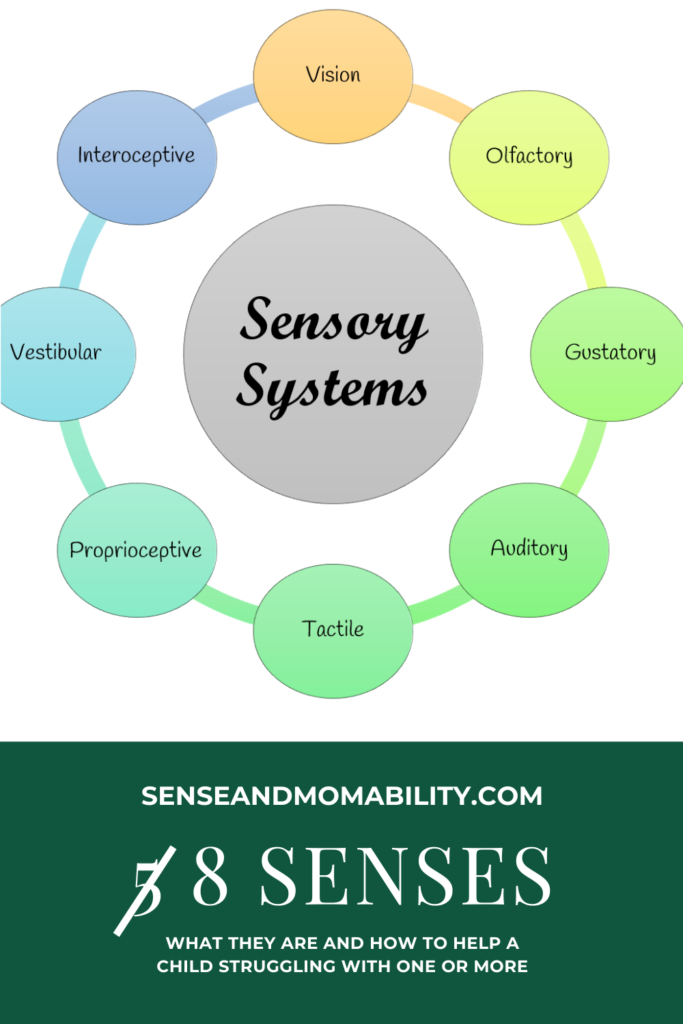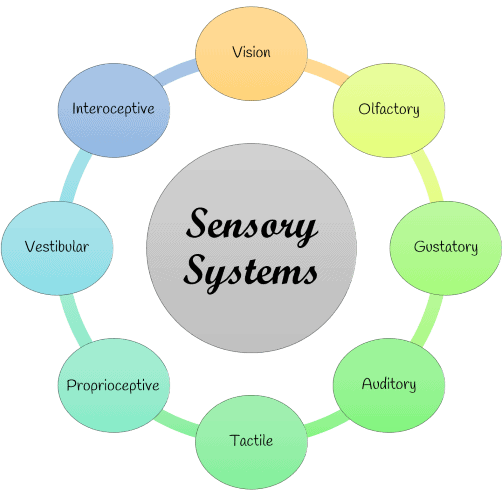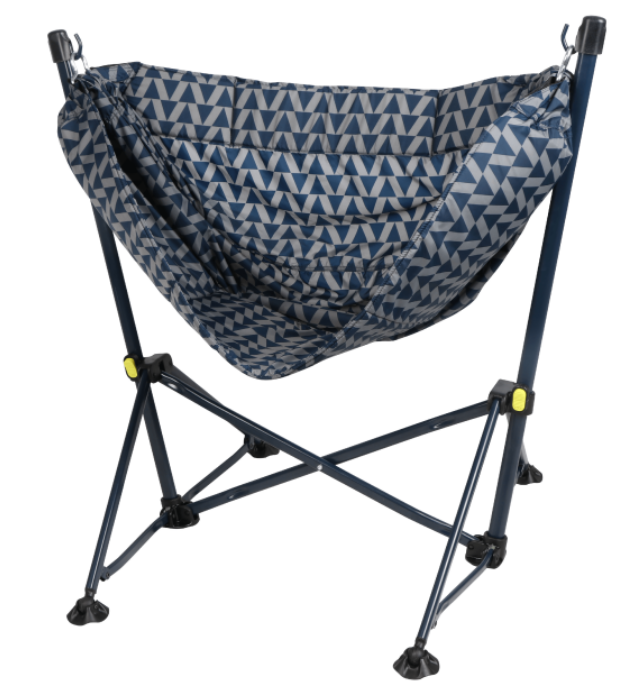8 Senses Series: Introduction
Welcome to Sense and MomAbility’s series: 8 Senses. In each post, you will…
- Learn a bit about what the sense is
- What signs to look for that your child is avoiding or seeking that sense
- Activities to help your child who is avoiding or seeking that sense
- Snag a free full-color printable on signs and activities for that sense
This post contains affiliate links. I earn a small commission if you make a purchase from this page. There is no additional cost to you, but it allows me to run this site and provide free printables. Thank you! Please see my disclosure for more details.
What is SPD?
Our nervous system takes information from our senses and interprets them. Sensory Processing Disorder occurs when there is a dysfunction in that system. 1
There are 8 senses, and a person with SPD may over respond or under respond to any of them. Your child may seek to chew on his clothes and oral-motor “chewies” but be overwhelmed by loud noises and bright lights (looking at you my E ❤️) .
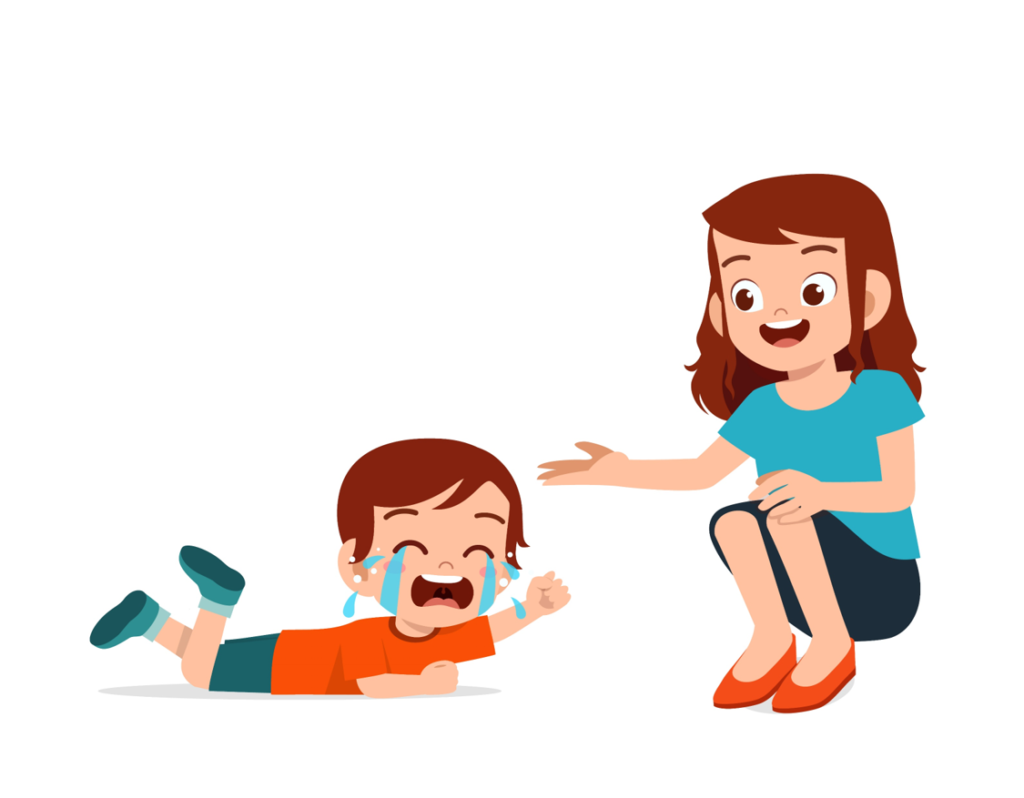
Tantrum or Meltdown?
With that dysfunction, comes stress. While a loud sound could be irritating to someone without sensory sensitivities, a child with them could literally feel pain. It can cause fear. If too much is happening or their sensory system is feeling “off” you child could go go into sensory overload and have a meltdown. The difference between meltdowns and tantrums will be discussed in a later post, but basically a meltdown is uncontrollable and a tantrum is behavioral. A child having a meltdown is scared, in pain, etc. while a child having a tantrum is trying to get a want met.
You or your child may not have SPD but still have some sensitivities in one or more of their sensory systems. Please stay tuned for the rest of the 8 Senses series to learn more!
The 8 Senses
Vision (Sight)
- This sense refers to what we perceive with our eyes.
- Symbols, light, nonverbal communication are part of our visual system.
- A child who tries anything to block out the bright morning sun may be overresponsive in his visual sense
- Intervention: Use sunglasses inside for short periods (E’s future is so bright he’s gotta wear shades).
- A child who is unable to track objects (follow an object with his eyes) may be underresponsive in his visual sense
- Intervention: Practice tracking dim lights in a dark room.
Olfactory (Smell)
- This sense refers to what we perceive with our nose.
- Smells are part of our olfactory system.
- A child who avoids the “smelly” stores at the mall may be overresponsive in his visual sense
- Intervention: Color with pleasantly scented markers/crayons.
- A child who does not mind or seeks out “unpleasant” smells may be underresponsive in his visual sense
- Intervention: Same as above. Also, play the below game or just smell the scents. I can’t recommended this enough!
Gustatory (Taste/Oral)
- This sense refers to what we perceive with our mouth.
- Taste and texture are part of our gustatory system.
- A child who is very picky with food may be overresponsive in his gustatory sense
- Intervention: Allow your child to explore new foods with his hands or mouth without requiring him to ingest it.
- A child who chews his clothes or bites may be underresponsive in his gustatory sense
- Intervention: Try out some of my recommended oral-motor products!
Auditory (Hearing)
- This sense refers to what we perceive with our ears.
- Sounds and volume are part of our auditory system.
- A child who claps his hands over his ears when loud or sudden sounds occur may be overresponsive in his auditory sense
- Intervention: Try out noise reducing headphones in loud environments. Ours listed below through Amazon has lasted us 3 years with moderate use – it comes in many colors under $20.
- A child who is able to focus on his homework better when background music is playing may be underresponsive in his auditory sense
- Intervention: Play relaxing music while getting ready for school. We often ask Alexa to play a classical playlist on volume 5! When E talks about his family members, he includes Alexa…. I can’t recommend the Echo enough.
Tactile (Touch)
- This sense refers to what we perceive with our skin.
- The sensation of touch to any part of our body, including pressure are part of our tactile system.
- A child who cannot handle tags or certain fabrics may be overresponsive in his tactile sense
- Intervention: Try out homemade sensory bins or play with homemade slime.
- A child who prefers tight clothing may be underresponsive in his tactile sense
- Intervention: Try a weighted blanket or compression shirt.
Proprioceptive
- This sense refers to how we perceive the interactions between body parts.
- Our muscles and joints are part of our proprioceptive system. It is about body awarness.
- A child who cannot handle tags or certain fabrics may be overresponsive in his proprioceptive sense
- Intervention: Practice heavy work – pick up heavy books, push a wall, etc.
- A child who uses too much force and breaks crayons while coloring may be underresponsive in his proprioceptive sense
- Intervention: Try out firm putty. We love Crazy Aaron’s Thinking Putty!
Vestibular
- This sense refers to how we perceive the interactions between our body and the environment.
- Balance and coordination are part of our vestibular system.
- A child who is afraid of playgrounds and escalators may be overresponsive in his vestibular sense
- Intervention: Engage in body movement activities like dancing.
- A child who climbs on all the furniture may be underresponsive in his vestibular sense
- Intervention: Use a swing or an indoor trampoline.
Indoor hammock chair – Walmart
Interoceptive
- This sense refers to how we perceive our bodily functions.
- Hunger, heart rate, and temperature are part of our interoceptive system.
- A child who complains of chronic pain may be overresponsive in his interoceptive sense
- Intervention: Soothe him with warm baths.
- A child who is delayed in potty learning may be underresponsive in his interoceptive sense
- Intervention: Read the post on potty learning. Gently switch to cotton training pants / cloth diapers to encourage feeling the sensation of wetness.
Download the Printable Here!
Subscribe to Sense and MomAbility to download this FREE printable and get instant access to all free SAM printables.

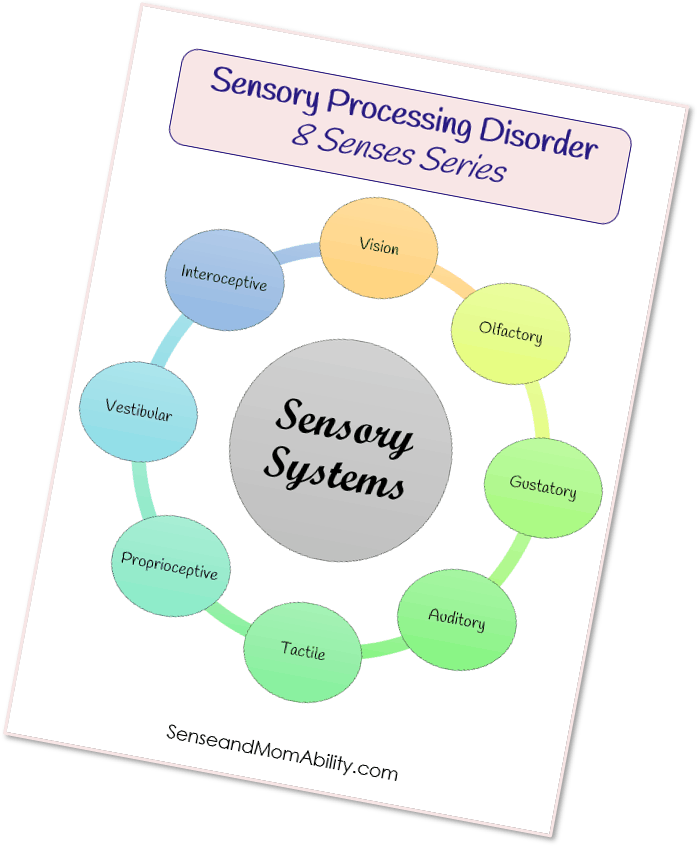
References/Acknowledgements
SPD Star. (2020). About SPD. Retrieved from https://www.spdstar.org/basic/about-spd
Baby vector created by colorfuelstudio – www.freepik.com
